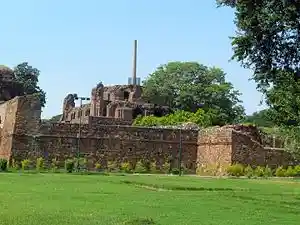THE CAPITAL CITY BY THE MEDIEVAL BUILDER- FIROZ SHAH KOTLA
The fifth capital of Delhi was constructed by one of the greatest builders of the medieval era- Firoz Shah Tughlaq.

Panaromic view of Firozabad. Image Courtesy: Wikimedia Commons
Delhi's sultanate was dominated by several rulers who sat on the throne for shorter durations. The same can be said for the Tughlaq Dynasty as well. Firoz Shah Tughlaq was a more stable ruler than his father Muhammad-bin-Tughlaq. Muhammad Bin Tughlaq made a lot of decisions that didn’t work to his advantage. One of them was the introduction of a token currency that unestablished the economic condition of the empire. However, Firoz Shah was a different ruler.
He built the next city of Delhi - Firozabad or Firoz Shah Kotla as it is known today. He was a famous builder of the medieval period and was known to dot the landscape of Delhi with numerous complexes and mosques. He expanded the city from old Indraprastha to the ridge. In 1354, he brought two sandstone pillars containing Ashokan inscriptions from Meerut and Ambala and placed one on the ridge and the other at Kotla Firozshah.
The Ashokan pillar from the 3rd century BC rises from the palace's crumbling remains. He built Khirki Masjid, Mausoleum and Madrasa in Hauz Khas which is a beautiful complex of the mosque. Kalan Masjid, Chausanth Khamba, Begumpur Masjid and the adjoining Bijai Mandal and Bada Khamba are other notable buildings that compose his reign. He is also credited with building several ghostly lodges in the forests of the Ridge. Among these lodges, Bhuli Bhatiyari ka Mahal, Pir Gab and Malcha Mahal still survive.
The rich heritage of Firoz Shah's building brought much glory and fame to the capital city. At the same time, its wealth, splendour and beauty posed a threat to plunder. Delhi went through a nightmare during a brief interval of two weeks in December 1398 when Delhi was plundered by Tamur Lang. This brought an abrupt end to the Tughlaq dynasty.
The next dynasty, the Lodi, left some tombs. The tomb of Sikandar Lodi (1489-1517) is noteworthy. The Bara Gumbad Mosque in Lodi Garden, built-in 1484, consists of sections and has three domes on top. The Sheesh Gumbad in Lodi Gardens was decorated with glazed tiles, hence the name 'Glass of Glass'.
A new chapter in the history of Delhi was rewritten in 1526. Babur established the Mughal dynasty by defeating Ibrahim Lodhi in the first battle of Panipat.

Ashokan Pillar at Firoz Shah Kotla. Image Courtesy: Wikimedia Commons


